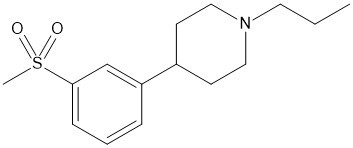Pridopidine | Sigma-1 ligand Neuroprotectant/Neurorestorative
NMR (Conforms)

Available Options
| Size: | Price | Quantity | |
|---|---|---|---|
| 5 mg | $80.00 | ||
| 25 mg | $325.00 |
Pridopidine (346688-38-8) is being studied as a potential treatment for Huntington’s disease, Parkinson’s disease, and schizophrenia based on its locomotor stabilizing and antipsychotic-like effects.1,2 It was, unusually, able to reverse both hypo- and hyperdopaminergia depending on local dopamine concentrations without inducing catalepsy. This was originally attributed to functional dopamine D2 antagonism with fast on/off kinetics (“dopamine stabilizer”).3 More recent studies have attributed pridopidine’s effects to its being a more potent sigma-1 ligand than a D2 ligand.4,5 Displays neuroprotective/restorative effects6,7 and ameliorates central features of amyotrophic lateral sclerosis pathology8 in a sigma-1-mediated manner
References/Citations:
1) Pettersson (2010), Synthesis and Evaluation of a Set of 4-Phenylpiperidines and 4-Phenylpiperazines as D2 Receptor Ligands and the Discovery of the Dopaminergic Stabilizer 4-[3-(Methylsulfonyl)phenyl]-1-propylpiperidine (Huntexil, Pridopidine, ACR16); J.Med.Chem. 53 2510
2) The dopamine stabilizers (S)-(-)-(3-methanesulfonylphenyl)-1-propyl-piperidine [(-)-OSU6162] and 4-(3-methanesulfonylphenyl)-1-propyl-piperidine (ACR16) show high in vivo D2 receptor occupancy, antipsychotic-like efficacy, and low potential for motor side effects in the rat; J.Pharmacol.Exp.Ther. 318 810
3) Dyhring et al. (2010) The dopaminergic stabilizers pridopidine (ACR16) and (-)-OSU6162 display dopamine D(2) receptor antagonism and fast receptor dissociation properties; Eur.J.Pharmacol. 628 19
4) Sahlholm (2015) Pridopidine selectively occupies sigma-1 rather than dopamine D2 receptors at behaviorally active doses; Psychopharmacology (Berl) 232 3443
5) Sahlholm et al. (2013), The dopamine stabilizers ACR16 and (-)-OSU6162 display nanomolar affinities at the s-1 receptor; Mol.Psychiatry 18 12
6) Francardo et al. (2019), Pridopidine Induces Functional Neurorestoration Via the Sigma-1 Receptor in a Mouse Model of Parkinson’s Disease; Neurotherapeutics 16 465
7) Ryskamp, et al. (2017), The sigma-1 receptor mediates the beneficial effects of pridopidine in a mouse model of Huntington disease; Neurobiol.Dis. 97(Pt A) 46
8) Ionescu et al. (2019), Targeting the Sigma-1 Receptor via Pridopidine Ameliorates Central Features of ALS Pathology in a SOD1G93A Model; Cell Death Dis. 10 210
NMR (Conforms)
Safety Data Sheet:
Product Data Sheet:
Materials provided by Focus Biomolecules are for laboratory research use only and are not intended for human or veterinary applications. Please note that we do not sell to individuals and that all orders placed by non-research organizations will incur a $20 restocking/refund fee
Pridopidine (346688-38-8) is being studied as a potential treatment for Huntington’s disease, Parkinson’s disease, and schizophrenia based on its locomotor stabilizing and antipsychotic-like effects.1,2 It was, unusually, able to reverse both hypo- and hyperdopaminergia depending on local dopamine concentrations without inducing catalepsy. This was originally attributed to functional dopamine D2 antagonism with fast on/off kinetics (“dopamine stabilizer”).3 More recent studies have attributed pridopidine’s effects to its being a more potent sigma-1 ligand than a D2 ligand.4,5 Displays neuroprotective/restorative effects6,7 and ameliorates central features of amyotrophic lateral sclerosis pathology8 in a sigma-1-mediated manner
References/Citations:
1) Pettersson (2010), Synthesis and Evaluation of a Set of 4-Phenylpiperidines and 4-Phenylpiperazines as D2 Receptor Ligands and the Discovery of the Dopaminergic Stabilizer 4-[3-(Methylsulfonyl)phenyl]-1-propylpiperidine (Huntexil, Pridopidine, ACR16); J.Med.Chem. 53 2510
2) The dopamine stabilizers (S)-(-)-(3-methanesulfonylphenyl)-1-propyl-piperidine [(-)-OSU6162] and 4-(3-methanesulfonylphenyl)-1-propyl-piperidine (ACR16) show high in vivo D2 receptor occupancy, antipsychotic-like efficacy, and low potential for motor side effects in the rat; J.Pharmacol.Exp.Ther. 318 810
3) Dyhring et al. (2010) The dopaminergic stabilizers pridopidine (ACR16) and (-)-OSU6162 display dopamine D(2) receptor antagonism and fast receptor dissociation properties; Eur.J.Pharmacol. 628 19
4) Sahlholm (2015) Pridopidine selectively occupies sigma-1 rather than dopamine D2 receptors at behaviorally active doses; Psychopharmacology (Berl) 232 3443
5) Sahlholm et al. (2013), The dopamine stabilizers ACR16 and (-)-OSU6162 display nanomolar affinities at the s-1 receptor; Mol.Psychiatry 18 12
6) Francardo et al. (2019), Pridopidine Induces Functional Neurorestoration Via the Sigma-1 Receptor in a Mouse Model of Parkinson’s Disease; Neurotherapeutics 16 465
7) Ryskamp, et al. (2017), The sigma-1 receptor mediates the beneficial effects of pridopidine in a mouse model of Huntington disease; Neurobiol.Dis. 97(Pt A) 46
8) Ionescu et al. (2019), Targeting the Sigma-1 Receptor via Pridopidine Ameliorates Central Features of ALS Pathology in a SOD1G93A Model; Cell Death Dis. 10 210
Related Sigma Receptors
Download
Calculate the molar concentration, mass or volume in a solution.
Concentration × Volume × Molecular Weight = Mass
Focus Biomolecules • Plymouth Meeting, PA USA • 1-855-FOCUS21
Focus Biomolecules
Plymouth Meeting, PA USA
1-855-FOCUS21
Website Created by Advanta Advertising LLC.

